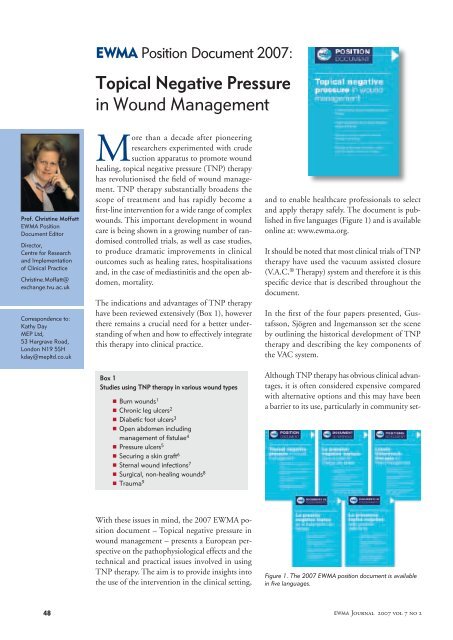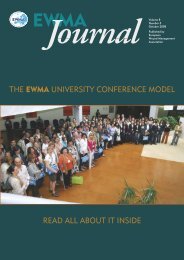Create successful ePaper yourself
Turn your PDF publications into a flip-book with our unique Google optimized e-Paper software.
Prof. Christine Moffatt<br />
<strong>EWMA</strong> Position<br />
Document Editor<br />
Director,<br />
Centre for Research<br />
and Implementation<br />
of Clinical Practice<br />
Christine.Moffatt@<br />
exchange.tvu.ac.uk<br />
Correspondence to:<br />
Kathy Day<br />
MEP Ltd,<br />
53 Hargrave Road,<br />
London N19 5SH<br />
kday@mepltd.co.uk<br />
<strong>EWMA</strong> Position Document 2007:<br />
Topical Negative Pressure<br />
in Wound Management<br />
More than a decade after pioneering<br />
researchers experimented with crude<br />
suction apparatus to promote wound<br />
healing, topical negative pressure (TNP) therapy<br />
has revolutionised the field of wound management.<br />
TNP therapy substantially broadens the<br />
scope of treatment and has rapidly become a<br />
first-line intervention for a wide range of complex<br />
wounds. This important development in wound<br />
care is being shown in a growing number of randomised<br />
controlled trials, as well as case studies,<br />
to produce dramatic improvements in clinical<br />
outcomes such as healing rates, hospitalisations<br />
and, in the case of mediastinitis and the open abdomen,<br />
mortality.<br />
The indications and advantages of TNP therapy<br />
have been reviewed extensively (Box 1), however<br />
there remains a crucial need for a better understanding<br />
of when and how to effectively integrate<br />
this therapy into clinical practice.<br />
Box 1<br />
Studies using TNP therapy in various wound types<br />
n Burn wounds 1<br />
n Chronic leg ulcers 2<br />
n Diabetic foot ulcers 3<br />
n Open abdomen including<br />
management of fistulae 4<br />
n Pressure ulcers 5<br />
n Securing a skin graft 6<br />
n Sternal wound infections 7<br />
n Surgical, non-healing wounds 8<br />
n Trauma 9<br />
With these issues in mind, the 2007 <strong>EWMA</strong> position<br />
document – Topical negative pressure in<br />
wound management – presents a European perspective<br />
on the pathophysiological effects and the<br />
technical and practical issues involved in using<br />
TNP therapy. The aim is to provide insights into<br />
the use of the intervention in the clinical setting,<br />
and to enable healthcare professionals to select<br />
and apply therapy safely. The document is published<br />
in five languages (Figure 1) and is available<br />
online at: www.ewma.org.<br />
It should be noted that most clinical trials of TNP<br />
therapy have used the vacuum assisted closure<br />
(V.A.C. ® Therapy) system and therefore it is this<br />
specific device that is described throughout the<br />
document.<br />
In the first of the four papers presented, Gustafsson,<br />
Sjögren and Ingemansson set the scene<br />
by outlining the historical development of TNP<br />
therapy and describing the key components of<br />
the VAC system.<br />
Although TNP therapy has obvious clinical advantages,<br />
it is often considered expensive compared<br />
with alternative options and this may have been<br />
a barrier to its use, particularly in community set-<br />
Figure 1. The 2007 <strong>EWMA</strong> position document is available<br />
in five languages.<br />
<strong>EWMA</strong> Journal 2007 vol 7 no 2

















